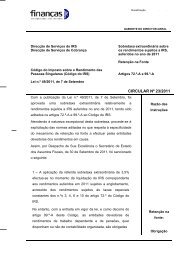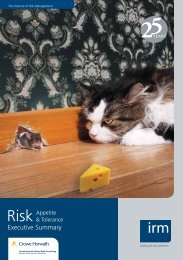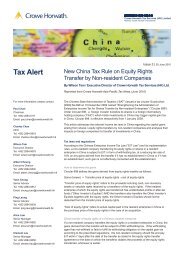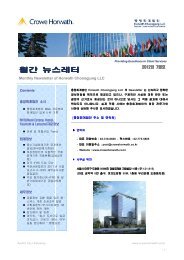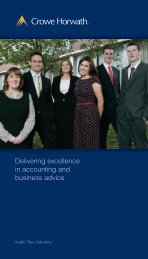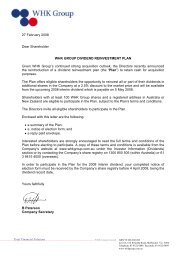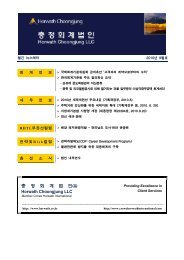March 2011 - Crowe Horwath International
March 2011 - Crowe Horwath International
March 2011 - Crowe Horwath International
Create successful ePaper yourself
Turn your PDF publications into a flip-book with our unique Google optimized e-Paper software.
<strong>March</strong> <strong>2011</strong><br />
Issue 01<br />
News from<br />
Private Clients<br />
Inside this issue<br />
Pre 5 April planning:<br />
Pensions<br />
New rules on tax relief limits<br />
Income tax<br />
Efficient use of rate bands and<br />
allowances can save over £22,000<br />
Tax-efficient<br />
investments<br />
Income tax relief, deferral of CGT and<br />
tax exempt income<br />
Gifts to Charity<br />
Plan your gifts to maximise tax relief<br />
Inheritance tax<br />
Simple annual gifts can save £2,400 a<br />
year<br />
Capital Gains Tax<br />
Use exemptions and losses to save tax<br />
Tax Calendar<br />
Key dates <strong>2011</strong>/12
<strong>Crowe</strong> Clark Whitehill<br />
£22,480 - income tax to be<br />
saved each year through<br />
efficient use of rate bands<br />
Pensions<br />
Pension Schemes remain an important<br />
means of tax-efficient saving for<br />
retirement, but the benefits have been<br />
restricted by a number of complex<br />
changes to the higher-rate tax relief<br />
available, with further changes taking<br />
effect from 6 April <strong>2011</strong>.<br />
In brief, if you have total income in<br />
excess of £130,000 for any of the<br />
years 2007/08, 2008/09, 2009/10 or<br />
the current tax year, ‘anti-forestalling’<br />
provisions introduced on 22 April 2009<br />
will apply and tax relief may be restricted<br />
on any pension payments made by you<br />
or your employer in excess of £20,000.<br />
This limit is extended in circumstances<br />
where there was a prior history of<br />
contributions being made before<br />
22 April 2009, dependent on both the<br />
amount and the frequency of those<br />
contributions.<br />
The rules change again from<br />
6 April <strong>2011</strong>. From that date, higher-rate<br />
tax relief will be available for everyone<br />
on contributions up to £50,000 each<br />
tax year with the ability to carry forward<br />
unused allowances for up to three tax<br />
years. Importantly, this new<br />
carry-forward provision is deemed to<br />
have been in place for 2008/09, 2009/10<br />
and 2010/11. It may therefore be better<br />
to wait until after 5 April <strong>2011</strong> before<br />
making a large pension contribution.<br />
Additionally, with effect from<br />
13 October 2010, the annual allowance<br />
for pension contributions is reduced<br />
from £245,000 to £50,000. This<br />
allowance applies for Pension Input<br />
Periods rather than tax years and where<br />
these two do not coincide, there is a<br />
risk that the annual allowance can be<br />
exceeded for contributions made since<br />
13 October 2010, triggering an income<br />
tax liability.<br />
Please contact us if you require further<br />
advice on this extremely complex issue.<br />
Please note that all references<br />
to spouses also include<br />
members of Civil Partnerships<br />
Income tax<br />
Ensuring that all allowances and tax bands available to you (and your spouse<br />
if appropriate) are used as effectively as possible is a good starting point when<br />
considering income tax planning. You should therefore consider transferring income<br />
producing assets between spouses to gain maximum advantage.<br />
2010/11 <strong>2011</strong>/12<br />
Personal allowance £6,475 £7,475<br />
Age allowance (65 to 74 years old) £9,490 £9,940<br />
Age allowance (75 years old and over) £9,640 £10,090<br />
Income limit for age allowance £22,900 £24,000<br />
Income limit for full personal allowance £100,000 £100,000<br />
Basic rate band (20%) £0 – £37,400 £0 – £35,000<br />
Higher rate band (40%) £37,401 – £150,000 £35,001 – £150,000<br />
Additional rate band (50%) Over £150,000 Over £150,000<br />
Charitable donations under Gift Aid or, in some cases, pension contributions can be<br />
made to reduce taxable income.<br />
It is worth noting that a child is entitled to the personal allowance, even in the year of<br />
birth. Where a grandparent provides the funds (e.g. cash deposits) which give rise to<br />
taxable income, the child’s personal allowance is available to set-off against the income.<br />
However, where a parent puts funds aside for their child, any income arising from those<br />
funds will be taxed on the parent unless that income is less than £100 per tax year.<br />
Tax-efficient investments<br />
The Individual Savings Account (ISA) is possibly the best-known form of tax-efficient<br />
investment ‘wrapper’. Although no tax relief is available on the initial investment, no<br />
additional tax is paid on income or capital gains arising within the ISA itself, irrespective<br />
of the length of time the ISA is held. In the current (2010/11) tax year, up to £10,200 can<br />
be invested in a ‘stocks and shares’ ISA and £5,100 for cash-only. Your ISA allowance<br />
cannot be carried forward to the next year, so use it or lose it!<br />
Investments into Venture Capital Trusts (VCTs) and Enterprise Investment Schemes<br />
(EISs) are increasingly popular. Limits are as follows:<br />
Income tax<br />
relief<br />
Many tax allowances and reliefs are<br />
available on a ‘use it or lose it’ basis<br />
- hence the need to review one’s tax<br />
affairs before the end of the tax year.<br />
Limit for<br />
income tax<br />
relief<br />
Minimum hold<br />
period<br />
Other tax<br />
benefits<br />
VCT 30% £200,000 5 years Tax free dividends<br />
EIS 20% £500,000 3 years CGT exempt on<br />
sale<br />
EIS investment also allows a deferral of capital gains realised in the period three years<br />
before to one year following the date of the acquisition of the EIS shares. Any such<br />
gains to the value of the sum subscribed fall back into charge on the disposal of the EIS<br />
shares.<br />
Insurance bonds have become an attractive means by which income tax liabilities<br />
can be managed or deferred. The main attraction is the ability to take a tax deferred<br />
withdrawal of up to 5% a year of the original capital on a cumulative basis (until the<br />
original capital has been exhausted). This provides opportunities to plan further<br />
withdrawals which would be subject to tax in a time which best suits you and when<br />
applicable tax rates are lower.
Private Clients Newsletter <strong>March</strong> <strong>2011</strong><br />
Use of IHT exemptions can<br />
save £2,400 each year, every<br />
year<br />
Gifts to Charity<br />
Charitable donations made under<br />
Gift Aid can assist in reducing taxable<br />
income levels if your income is above<br />
£100,000, thereby avoiding the<br />
withdrawal of the tax-free personal<br />
allowance and also avoiding the<br />
restrictions on tax relief for pension<br />
contributions if your income is above<br />
£130,000.<br />
Capital Gains<br />
Tax (CGT)<br />
Cash donations can be made after<br />
5 April <strong>2011</strong> (but before you submit your<br />
2010/11 Tax Return) and ’carried back’<br />
to 2010/11, provided that your Tax<br />
Return is filed by 31 January 2012.<br />
Tax relief is also available on the gift of<br />
quoted investments and of UK land and<br />
property to charity. There is, however,<br />
no equivalent ‘carry back’ provision – to<br />
be relieved in 2010/11, the gift must be<br />
completed by 5 April <strong>2011</strong>.<br />
Inheritance<br />
Tax (IHT)<br />
The annual exemption for gifts by any<br />
one donor has been £3,000 for many<br />
years now. Consider making use of the<br />
2010/11 annual exemption, together<br />
with that for last year if not already used.<br />
Remember each spouse has his or her<br />
own £3,000 annual exemption. Use<br />
of these exemptions can mean an IHT<br />
saving of £2,400 each year, every year.<br />
Small gifts of £250 to any one donee are<br />
also exempt.<br />
An IHT exemption that is often<br />
overlooked is that for normal gifts out of<br />
income. Such gifts will qualify if they are<br />
made as part of the normal (i.e. typical<br />
or habitual) expenditure of the donor out<br />
of his income, and that after the gifts the<br />
donor is left with sufficient income to<br />
maintain his usual standard of living. For<br />
more details of this exemption please<br />
contact us.<br />
For 2010/11 gains of £10,100 are exempt<br />
from CGT. This annual exempt amount<br />
cannot be carried forward and is lost if<br />
unused in the year.<br />
Ignoring entrepreneurs’ relief (see below),<br />
two rates of CGT apply to gains realised<br />
from 23 June 2010. Capital gains are<br />
treated as the top slice of income, and<br />
those which fall within the basic rate<br />
band (£37,400) are taxed at 18%, with<br />
any excess liable at 28%. Gains realised<br />
prior to 23 June 2010 are not taken into<br />
account in determining whether the 18%<br />
or 28% CGT rate will apply.<br />
In this year of two rates of CGT,<br />
HM Revenue & Customs (HMRC) will<br />
allow individuals to set losses against<br />
those gains taxable at the highest rate of<br />
tax. It may be worthwhile selling assets<br />
to realise a loss. The transfer of an<br />
asset between spouses who are living<br />
together is tax neutral. Consider taking<br />
advantage of this to use a spouse’s<br />
unused annual exempt amount and/or<br />
basic rate band or to realise a loss.<br />
Entrepreneurs’ relief is available on the<br />
disposal of business assets, where CGT<br />
is charged on gains of up to £5 million at<br />
only 10%. There are complex qualifying<br />
conditions for business assets and these<br />
should be kept under constant review as<br />
the conditions must be met throughout<br />
the 12 months before sale.<br />
Deferring selling an asset until after<br />
5 April <strong>2011</strong> will allow the use of next<br />
year’s annual exempt amount, and will<br />
defer the due date of payment of the<br />
CGT liability by one year to 31 January<br />
2013. Alternatively, consider selling part<br />
of an asset in the current year and part<br />
after 5 April <strong>2011</strong> to take advantage of<br />
the annual exempt amounts and basic<br />
rate bands available in both years. The<br />
key date for CGT purposes is the date<br />
of the contract to dispose of the asset in<br />
question.<br />
To use this year’s annual exemption,<br />
consider selling an asset and having<br />
that same asset reacquired by your ISA,<br />
pension scheme or your spouse. Selling<br />
and reacquiring the same asset within<br />
the same 30 day period does not realise<br />
a gain. General anti-avoidance legislation<br />
means that care should be taken when<br />
using alternative strategies to bed and<br />
breakfasting to create losses, and we<br />
recommend you take further advice<br />
from us before doing so.<br />
Capital losses arising in 2010/11 on<br />
the disposal of shares acquired by<br />
subscription in unquoted (or AIM listed)<br />
trading companies may be offset against<br />
taxable income in the year giving tax<br />
relief at up to 50%.
Private Clients Newsletter <strong>March</strong> <strong>2011</strong><br />
Tax Calendar<br />
Key dates<br />
23 <strong>March</strong> <strong>2011</strong>: Budget day<br />
5 April <strong>2011</strong>: <strong>2011</strong> tax year end<br />
6 April <strong>2011</strong>: HMRC issues <strong>2011</strong> notices to file tax returns<br />
31 July <strong>2011</strong>: Further £100 penalty for late 2010 tax returns<br />
Further 5% surcharge on any unpaid tax for 2009/10<br />
Second payment on account due for 2010/11<br />
31 August <strong>2011</strong>: Tax return information to be sent to <strong>Crowe</strong> Clark Whitehill<br />
5 October <strong>2011</strong>: Notify HMRC of chargeability to tax where no notice to file issued<br />
31 October <strong>2011</strong>: Deadline for filing paper <strong>2011</strong> tax returns<br />
30 December <strong>2011</strong>: Deadline for <strong>2011</strong> tax return if underpayment is to be coded<br />
31 January 2012: Final deadline for on-line filing of <strong>2011</strong> tax returns<br />
Balancing payment due for 2010/11<br />
First payment on account due for <strong>2011</strong>/12<br />
28 February 2012: 5% surcharge on any unpaid tax for 2010/11<br />
We hope you find this newsletter of interest.<br />
If you have any queries about any of the<br />
topics covered, please call your regular <strong>Crowe</strong><br />
Clark Whitehill contact.<br />
Office locations<br />
Tim Norkett<br />
020 7842 7151<br />
David Ford<br />
020 7842 7297<br />
Tom Elliott<br />
020 7842 7372<br />
Neil Bailey<br />
020 7842 7302<br />
Cheltenham<br />
01242 234421<br />
London<br />
020 7842 7100<br />
Manchester<br />
0161 214 7500<br />
Thames Valley<br />
0118 959 7222<br />
Kent<br />
Maidstone<br />
01622 767676<br />
Tunbridge Wells<br />
01892 700200<br />
Midlands<br />
Kidderminster<br />
01562 60101<br />
Walsall<br />
01922 725590<br />
Associate member of<br />
<strong>Crowe</strong> Clark Whitehill<br />
Isle of Man<br />
01624 627335<br />
The office in the Isle of Man is <strong>Crowe</strong> Clark Whitehill LLC. It is a separate,<br />
independent firm and not part of <strong>Crowe</strong> Clark Whitehill LLP. Accordingly, this firm<br />
cannot be held liable for the acts or omissions of each other.<br />
<strong>Crowe</strong> Clark Whitehill LLP is a member of <strong>Crowe</strong> <strong>Horwath</strong> <strong>International</strong>, a Swiss verein (<strong>Crowe</strong> <strong>Horwath</strong>). Each member firm of <strong>Crowe</strong> <strong>Horwath</strong> is a separate and independent legal<br />
entity. <strong>Crowe</strong> Clark Whitehill LLP and its affiliates are not responsible or liable for any acts or omissions of <strong>Crowe</strong> <strong>Horwath</strong> or any other member of <strong>Crowe</strong> <strong>Horwath</strong> and specifically<br />
disclaim any and all responsibility or liability for acts or omissions of <strong>Crowe</strong> <strong>Horwath</strong> or any other <strong>Crowe</strong> <strong>Horwath</strong> member. © <strong>2011</strong> <strong>Crowe</strong> Clark Whitehill LLP<br />
This information is published without the responsibility on our part for loss occasioned to any person acting or refraining from acting as a result of any information published herein.






